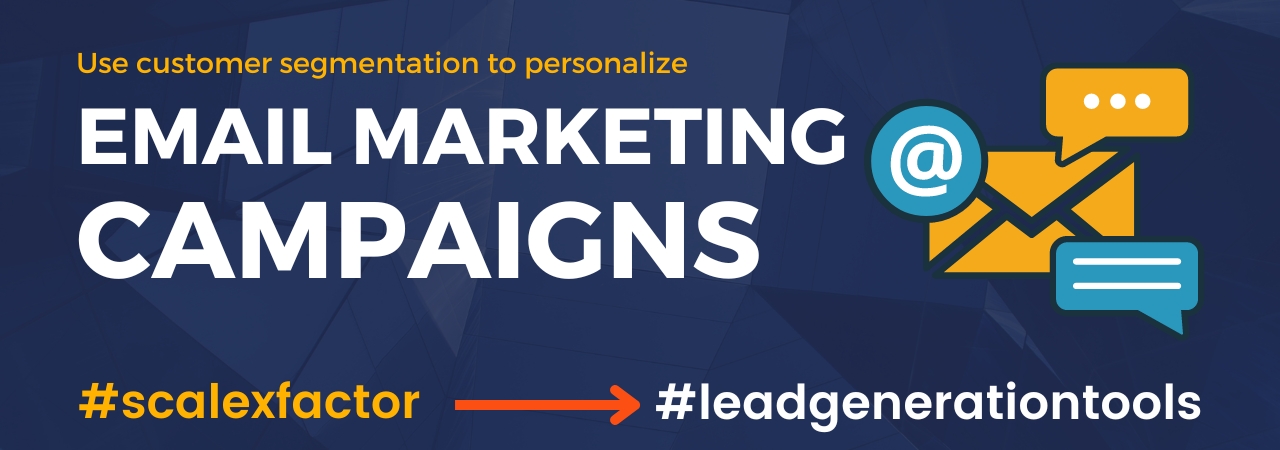Get ready to unlock the secrets of successful Lead Generation with the incredible power of Lead Generation Tools! At ScaleXFactor, we bring you the 26th installment of our 33-part series, “101 Ways of Lead Generation with Lead Generation Tools.” In this segment, we delve into three vital techniques that will transform your lead generation game.

Discover how to craft a targeted content marketing strategy that will magnetize prospects to your brand. Learn the art of customer segmentation for personalized email campaigns that resonate with each recipient. Finally, harness the authenticity of user-generated content from social media to drive lead generation like never before.
Let’s embark on this exciting journey to supercharge your business with the magic of Lead Generation Tools!
Point 76: Develop a targeted content marketing strategy to attract and engage prospects.
Are you looking to attract more leads and engage your prospects effectively? Crafting a targeted content marketing strategy is the key to success! By tailoring your content to resonate with your ideal audience, you can boost lead generation and conversion rates.

Pro:
- Increased Relevance: Targeted content addresses specific pain points of your audience, making it more relevant and valuable to them.
- Improved Conversion Rates: Engaging content tailored to prospects’ needs increases the likelihood of converting them into leads.
- Enhanced SEO Performance: Targeted content helps boost your website’s search engine rankings, driving more organic traffic.
- Stronger Brand Connection: Tailoring your content creates a stronger emotional bond between prospects and your brand.
- Cost-Effective: Focusing on targeted content ensures you invest resources where they are most likely to yield results.
Cons:
- Time-Consuming: Crafting targeted content requires thorough research and planning, which can be time-intensive.
- Narrow Focus: Relying solely on targeted content might limit your reach to a broader audience.
- Creativity Challenges: Balancing creativity with precise targeting can be challenging for some marketers.
- Evolving Audience: Regularly updating content to match changing audience needs can be demanding.
- Data Dependency: Targeted content heavily relies on accurate customer data, which may pose privacy concerns.
FAQs:
Q1: How can I identify my target audience?
A: Conduct market research, analyze customer data, and create buyer personas based on demographics, interests, and pain points.
Q2: What types of content work best for targeted marketing?
A: Content formats like blogs, eBooks, videos, and infographics work well for delivering targeted messages.
Q3: Is targeted content suitable for B2B businesses?
A: Absolutely! Even in B2B marketing, understanding and catering to specific pain points of decision-makers is essential for lead generation.
Point 77: Use customer segmentation to personalize email marketing campaigns.
Is your email marketing lacking the personal touch it needs to convert prospects into loyal customers? Customer segmentation is your solution! By dividing your audience into distinct groups based on common characteristics, you can create personalized email campaigns that resonate with recipients.

Pro:
- Higher Engagement: Personalized emails lead to increased open and click-through rates, fostering engagement.
- Reduced Unsubscribes: Relevant content reduces the likelihood of recipients unsubscribing from your mailing list.
- Improved ROI: Targeted emails generate more qualified leads, ultimately leading to a higher return on investment.
- Enhanced Customer Experience: Customers appreciate content tailored to their preferences, strengthening brand loyalty.
- A/B Testing Opportunities: Segmentation allows you to A/B test different messages, refining your campaigns over time.
Cons:
- Data Management: Handling and analyzing customer data for segmentation requires efficient data management tools.
- Initial Setup Time: Creating customer segments and personalized campaigns may require time initially.
- Over personalization: Excessive personalization can feel intrusive, so striking the right balance is crucial.
- Limited Resources: Small businesses with limited data might face challenges in creating highly specific segments.
- Segment Exhaustion: Over time, some segments may receive repetitive content, leading to decreased engagement.
FAQs:
Q1: How can I segment my email list effectively?
A: Segmentation can be based on demographics, purchase history, behavior, or engagement levels.
Q2: Is customer segmentation only for large businesses?
A: No, even small businesses can benefit from segmentation to create more relevant and engaging email campaigns.
Q3: How often should I update my customer segments?
A: Regularly review and update your segments based on changing customer behavior and preferences.
Point 78: Leverage user-generated content from social media for lead generation.
Struggling to find authentic ways to generate leads? Look no further than user-generated content (UGC) from social media! UGC, created by your customers, can significantly boost your lead generation efforts and establish trust in your brand.

Pro:
- Authenticity: UGC reflects real experiences and opinions, fostering authenticity and credibility for your brand.
- Cost-Effective: Harnessing UGC eliminates the need for expensive photo shoots or content creation.
- Increased Engagement: UGC often garners higher engagement rates, creating a sense of community among your audience.
- Diverse Content: UGC provides a variety of content, catering to different customer segments effectively.
- Trust and Social Proof: Positive UGC acts as social proof, reassuring prospects about the quality of your products or services.
Cons:
- Quality Control: Ensuring the quality of UGC may require moderation to filter out inappropriate content.
- Brand Alignment: Not all UGC might align perfectly with your brand image, requiring careful selection.
- Dependency on Customers: Relying solely on UGC may limit your content creation options.
- Copyright Issues: Permission from customers to use their content is essential to avoid copyright problems.
- Limited Control: UGC might not always convey the precise message you want to deliver.
FAQs:
Q1: How can I encourage customers to create UGC?
A: Host contests, create branded hashtags, and offer incentives to motivate customers to share their experiences.
Q2: What platforms are best for UGC collection?
A: Instagram, Facebook, Twitter, and TikTok are popular platforms for generating UGC.
Q3: Can I use UGC for advertising purposes without explicit permission?
A: No, always seek explicit permission from customers before using their content for advertising or promotional purposes.




